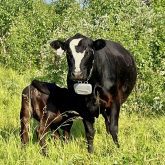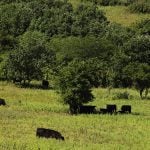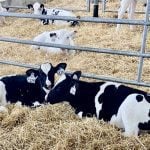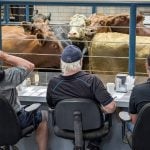Brett McRae, a rancher from Brandon, Man., recognizes how necessary versatility is in a changing industry.
“Where’s the need? What is the market telling us that it’s looking for, and how can we provide that?” he says.
In recent years he has made changes to his operation to continue striving for success.
Read Also

Building demand together: The impact of Canada’s beef import levy
The beef import levy has become a central tool for ensuring balance in Canada’s beef industry
Simplifying
McRae operates a mixed operation where he runs a commercial cattle herd of around 250 head alongside his grain operation, where he grows primarily wheat, oats, rye, canola, soybeans and corn.
McRae has been doing professional development for himself and his operation for years. He was part of the Canadian Cattle Young Leaders program in 2014-15 and took the Ranching for Profit course three times.
For many years, he has had a purebred operation alongside his commercial one. However, in recent years he felt like resources were spread too thin, so he sold the purebred herd to focus his efforts on commercial cattle. The McRaes now run two herds — commercial cows and replacement heifers.
“We were getting a little bit spread too thin. It was a big decision to sell off the purebred cows, I’ve built that herd all of my life. But looking back, we’re really happy with the decision.”
One benefit is that the commercial herd is more mobile, and easier to manage on his land base, which is spread out.
As they are devoting more time to their commercial cattle, they are focusing on adding value through replacement heifers.
“I really like growing heifers and selling a product versus a commodity. I like having that relationship with our customers,” McRae says.
“You take a heifer calf, expose her to a bull, you now have a bred heifer. You’ve added value to that. And then the other nice thing I really like about heifers is it gives us a lot of options… with heifers, you have the beef options, you can keep them, you can sell them. There’s a few different roads you can go down.”
Ranching for Profit
McRae has also made sure he’s constantly learning, to ensure he can adapt the operation. In July 2015, McRae took Ranching for Profit for the first time. At the time, he was part of the Canadian Cattle Young Leader’s program, and his mentor recommended the school.
McRae attended the school three times — twice to solidify the knowledge and a third time so his wife could take the course, as well.
Now, they’re involved in the Executive Link program, a network of Ranching for Profit alumni that provides members with professional development training, peer-review board meetings and experienced facilitators. For McRae and his operation, Executive Link has been a game changer.
“We really found the program to be a good fit.” He says the biggest benefits have been confidence in their decision-making and accountability when pushing forward.
Executive Link has allowed him to use the expertise of ranchers from across North America when making changes to his operation.
“This is a room full of really sharp people, and this is the right room to be in,” McRae says of the program.
Importance of adaptability
Being adaptable in the agricultural industry is pivotal for the success of an operation. Eric Micheels, an associate professor at the College of Agriculture and Bioresources at the University of Saskatchewan, says farmers and ranchers should be open to any type of change, such as having a new member involved in management, new technology or a necessity-driven change to reach a financial or production goal.
Micheels says sometimes people resist change because the outcome is uncertain.
“Depending on the nature of the change, sometimes we feel in agriculture that it is better to fail conventionally than to try something ‘too new’,” Micheels wrote in an email. “At the same time, the status quo is a known entity, and in some sense, managers might believe — somewhat rightly — that their continued existence would suggest that decisions and actions they have made in the past have been successful.”
However, he says just because a process or business model was successful in the past does not mean it will be successful in the future, and there are often many benefits to implementing change. To combat resistance, Micheels says communication and an open mind are important.
“The other key factor here is remembering that Rome wasn’t built in a day. For a farm business that has not gone through many change processes in the past, starting small and perhaps working with a lender or consultant, or even a business coach, may help all parties understand the issues and develop tools to overcome the reluctance to change.”
Planning is also helpful when managing the stress of change.
“We all know that the implementation of the actual change will not exactly match the plan, but having the plan in place is a good starting point. The planning capability might be more important than the actual plan.”
Continuing change
The future is bright for McRae and his operation, and his inclination toward learning and adapting to fit the industry continues. Currently, he rents 90 per cent of the land he uses, so he is looking for a ranch to purchase to call home.
He also is hoping to continue to expand his operation, something which may be more manageable now that he has streamlined the cattle side of the business.
“I think we have a pretty good product now. We’re arguably, probably, still too diverse… But we’re really focusing on having two-ish cattle enterprises. We’re narrowing in our crop rotation a little bit.”
One thing at the forefront of his mind is the need to stay adaptable. McRae wants to continue learning, changing and working to stay relevant and successful in a volatile industry.
“I think these days if you’re not moving forward, if you’re standing still, you’re getting left in the dust. We’ve maybe seen that a bit and been caught flat-footed before. So we’re really looking at what’s driving our business, and how can we be moving forward all the time.”
– Melissa Jeffers-Bezan is a field editor for Canadian Cattlemen and a graduate of the University of Regina School of Journalism. She grew up on a commercial cattle farm in western Manitoba, and is now based out of Regina.

















